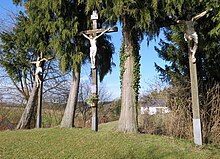Kalvarienberg (Aiterbach)
The Kalvarienberg is a crucifixion group above Aiterbach in the municipality of Allershausen (Upper Bavaria). It was built between 1845 and 1846 on a hill overgrown with spruce trees on the northeastern edge of the village opposite the subsidiary church of St. Brictius and depicts the crucifixion of Jesus Christ on Mount Golgotha .
description
The group is still original with small changes. It consists of three larger-than-life wooden Latin crosses . In barockisierender be because the figures of Jesus Christ and the two thieves executed with him representation Dismas and Gestas . The south-eastern ascent to the crosses, the Holy Staircase , is lined with stone wayside shrines , in which the first twelve stations of the Way of the Cross are shown. The initially erected wooden statues had to be replaced in 1859. On the south side of the hill there are four underground tomb chambers in which the tomb of Jesus and small altars are built. When the wooden chambers became dilapidated, the building authorities of the Freising District Office blocked access in 1862, and in 1901 they were completely abandoned. The chambers have now been filled with concrete and now form the last station on the Way of the Cross. Originally, the ensemble also included two figures of Johannes and Maria . They are missing today, as is the western staircase to the hill.
history
The citizens of Aiterbach gave the impetus for the construction of the site. The Allershausen village pastor Andreas Klarer therefore asked the Archbishop's Ordinariate in Munich for consent. On April 14, 1845 he wrote:
“ The Aiterbach branch community wants to erect a large seven-shoe high crucifix picture with the two thieves on a spherical hill opposite the church, and on the way to set up the stations of the cross in painted pictures. "
When this plan was approved a few days later, the villagers began construction. The community bore the costs. After almost a year of construction, the Calvary was consecrated on Whit Monday 1846.
In the 19th century it developed into a Catholic pilgrimage site . Numerous votive tablets from this time testify to the needs with which the pilgrims came to Aiterbach at that time.
The complex was threatened by decay several times, and the devotions also came to a standstill in the meantime. Twice, in 1915 and 1978/79, it was extensively restored by the townspeople. Every year in the week before Easter , a replica of the Holy Sepulcher is set up in the village church . A procession leads from her up the mountain on Good Friday . At the stations of the cross it is interrupted for prayers. In order to replace the church bells, which do not ring between Good Friday and Easter, the residents of the place are called to this ritual with wooden ratchets . Another devotion on the Way of the Cross takes place on the feast of the Exaltation of the Cross on September 14th .
Individual evidence
- ↑ a b c d Rudolf Goerge: Vom Kalvarienberg in Aiternbach. In: sheets for German national history. Volume 119, 1983, pp. 268–272, online (PDF, 1.0 MB)
- ↑ Filialkirche St. Brictius - Aiterbach. ( Memento of the original from May 2, 2016 in the Internet Archive ) Info: The archive link was inserted automatically and has not yet been checked. Please check the original and archive link according to the instructions and then remove this notice. Archdiocese of Munich and Freising , January 5, 2016, accessed on May 2, 2016
Coordinates: 48 ° 27 ′ 19.2 ″ N , 11 ° 36 ′ 14 ″ E

















